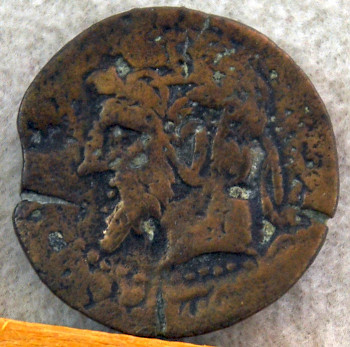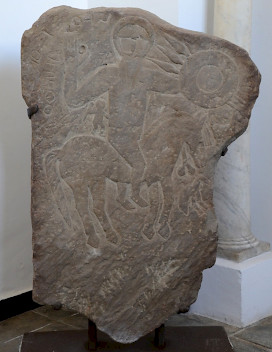Numidian-Carthaginian War
Numidian-Carthaginian War: the conflict between the Numidians and the Carthaginians in 151-150 BCE, pretext for a Roman intervention that culminated in the sack of Carthage (146 BCE).
Prelude

In the Second Punic War (218-201), the Roman Republic had defeated Carthage. The peace treaty forbade the defeated Carthaginians to wage wars without permission of the Roman Senate. For Rome's Numidian ally king Massinissa, this was, of course, an invitation to attack the Carthaginian possessions.note Moreover, the Carthaginians were to pay a large indemnity, which would take fifty years. By the mid-second century CE, Carthage would be free from this obligation, and at least one Roman senator, Cato the Elder, was under the impression that the former enemy would soon be a superpower again.
Problems
In 151 BCE, the Carthaginians, following a suggestion by Hamilcar the Samnite, expelled forty members of the pro-Numidian faction, which had once founded by Hannibal the Starling. They fled to Cirta, the residence of Massinissa, who sent his sons Gulussa and Micipsa to Carthage, to ask the city to receive back the exiles. The embassy was unsuccessful: after the two princes had reached Carthage, they were sent away.note Worse, Hamilcar the Samnite and his supporters attacked Gulussa's convoy and killed some of his attendants. This was something the Numidians could not left unanswered. War had become inevitable.
It is possible that the problems had began earlier. In that same year, prince Gulussa visited Rome and reported that the Carthaginians were preparing for war. They were building a navy and conducting a levy.note Our source, an excerpt from Livy' great History of Rome since the Beginning, is often confused and clumsy and we do not know where this piece of information must be placed: before or after the incident mentioned above.
Numidian attacks

However this may be, Massinissa saw an opportunity for territorial gain, invaded the Carthaginian realm, and attacked a town called Oroscopa. In response, the Carthaginians sent their commander Hasdrubal with an army of 400 cavalry and 25,000 infantry.note As he approached, two Numidian commanders, Asasis and Suba, decided to switch sides, taking no less than 6,000 horsemen with them.note However, in spite of this and other successes, Hasdrubal's luck was already running out.
In the spring, Massinissa retreated and lured the Carthaginian army to an isolated and deserted area. Hasdrubal followed and the two armies, which had both been reinforced, prepared for battle. The fight lasted well for hours and the losses were immense, but when the sun went down, it seemed that the Numidians had had the better of it.note
When Massinissa returned to his tent, he learned that he had a visitor from Rome: Publius Cornelius Scipio Aemilianus. He was, at that time, serving as a tribune in the Celtiberian War and had been sent to Numidia to obtain war elephants. As descendant of Publius Cornelius Scipio Africanus, who had once defeated Hannibal and made Massinissa king, the Roman guest was also the patron of the Numidian dynasty. His presence was noted by the Carthaginians as well, who requested him to negotiate an armistice. The Roman officer did his best, but the Numidian demand that deserters from the Numidian army, now serving Carthage, would be handed over, was unacceptable for the Carthaginians. Scipio returned to Iberia, together with the elephants.note
New hostilities
There were still Roman negotiators around when war was resumed. Massinissa laid siege to Hasdrubal's camp, surrounding it with siege works, trying to starve the Carthaginians into submission. The besieged believed they had still time to attempt a break-out, and waited for the negotiators, who might solve the conflict without further bloodshed. However, the Roman diplomats were not looking for peace. They had orders to encourage Massinissa to fight and to conduct negotiations only when the Numidian leader was defeated.note So, the blockade continued, but by now the Carthaginians were took weak to break out. The Greco-Roman historian Appian of Alexandria, our main source, tells that Hadrubal's men were eating their horses and pack animals; diseases were now inevitable, especially since there was no wood to build pyres, which meant that the dead were left unburied.note
In the end, the Carthaginians were forced to accept Massinissa's demands. They had to hand over the Numidian deserters, would accept the forty exiles, and agreed to pay Massinissa a hundred talents of silver for fifty years.note After this, the men were sent under a yoke: the usual humiliation of a defeated army. This was not the end of their suffering, because Gulussa still had revenge on his mind. With his horseman, he attacked the unarmed Carthaginian soldiers.note
Consequences
Although the Carthaginians had avoided territorial losses, the war ended in a disaster. In 201, they had agreed to ask permission from the Roman Senate before they would go to war. Obviously, Scipio Aemilianus and the other Roman diplomats had seen something else. Carthage had broken the peace treaty and Rome would use this as pretext to declare war.
It had every reason to do so. Scipio had observed one of the larges battles in history. He is quoted as having said that "he had witnessed various contests, but never enjoyed any other so much, for here only had he seen at his ease 110,000 join battle". Having stood on a hill, he modestly compared himself to "the only two who had had such a spectacle before him: Jupiter from Mount Ida, and Neptune from Samothrace, in the Trojan War".note
He and the other diplomats must have realized that if Carthage, which had mustered more than 50,000 men, would not return to its former power, Massinissa would one day capture Carthage, and Numidia would be an equally dangerous enemy. So, Rome decided to conquer the Carthaginian territory. The Third Punic War had become inevitable.